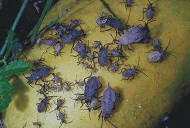|
Honeydew, cucurbit insects, bagworms
 Send a link to a friend
Send a link to a friend
[July
06, 2011]
Sticky mess under trees -- People are
beginning to complain about leaking sap coming from trees. Actually
this has been going on for a week or so. What happens is a fine mist
of sap coats things beneath a tree. This is actually called
honeydew, which is a secretion of sucking insects such as aphids and
lace bugs. What makes matters worse is a fungus begins growing in
the honeydew, making it turn black.
|
|
There are two ways to deal with the problem. The first
way is to spray the entire tree with a product such as malathion
to kill the insects. The second way is to move anything portable
from under the tree. If you opt for the first option, you need
to make sure you can spray the entire tree. The kind of weather
predicted will increase aphid numbers at a very great rate.
Cucurbit insects
Cucurbits are basically everything in the squash and melon
families. There are several potential insect problems with them,
and today's column attempts to help minimize or prevent these
problems.
In the first group of problem insects are the cucumber
beetles. These can be green, black and yellow striped, or black
and yellow spotted. They are also called corn rootworm beetles
when they are in cornfields. When these insects are in
cucurbits, they are usually called cucumber beetles. The
importance of the beetles is not that they eat small holes in
the leaves, but that the striped and spotted beetles can
transmit a bacterial wilt to the plants as they eat. The first
thing you see is you have a plant that suddenly wilts on various
runners, or the entire plant. The best means of controlling this
disease is a good beetle control program. Current homeowner
recommendations would include these products, with the
days-to-harvest restrictions in parentheses: carbaryl (none),
bifenthrin (three days) or rotenone (one day).
Of course, Japanese beetles love cucurbits as well. Their
damage is direct leaf feeding. Remember, they feed in groups, so
once they get started, you will have a battle on your hands. The
carbaryl and bifenthrin are both good control measures.
[to top of second column] |
 Squash bugs are the next problem to discuss. Squash bugs are
usually dark gray to black in color and like a long stink bug. Their
eggs usually hatch in mid-June to mid-July. The best control timing
is when the eggs first hatch. Nonrestricted products are sabadilla
(one day), which is an organic product that might be a little hard
to find, and bifenthrin (three days to harvest). One last note: If
the squash bugs get past their early growth stages, then physically
removing them is about the only control method available. Squash bugs are the next problem to discuss. Squash bugs are
usually dark gray to black in color and like a long stink bug. Their
eggs usually hatch in mid-June to mid-July. The best control timing
is when the eggs first hatch. Nonrestricted products are sabadilla
(one day), which is an organic product that might be a little hard
to find, and bifenthrin (three days to harvest). One last note: If
the squash bugs get past their early growth stages, then physically
removing them is about the only control method available.
The last insect problem on cucurbits is squash vine borers. These
borers usually drill into the new runner areas and kill off
individual runners one at a time. The adults of these larvae are red
and black clearwinged moths. Scout your plants and look for the
adults, as well as entrance holes and the chewed-up plant material.
Treat as soon as early damage occurs and use one of the following
homeowner products: carbaryl, bifenthrin or rotenone.
Days-to-harvest restrictions have already been covered (and these
would also apply to pumpkin blossoms).
Bagworm reminder
If you haven't checked for bagworms yet, now would be a good
time. I've seen some this year of three-fourths-inch bag size.
Re-treatment may be necessary in some cases. Sevin will work on the
smaller sized bagworms, while the Bt products may be required for
the larger ones.
Remember, bagworms frequently start in the tops of trees.
Bagworms are the larvae of clearwing moths that don't fly too well.
If you control the bagworms well, you may not have high populations
for a few years.
[By
JOHN FULTON,
University of Illinois Extension] |